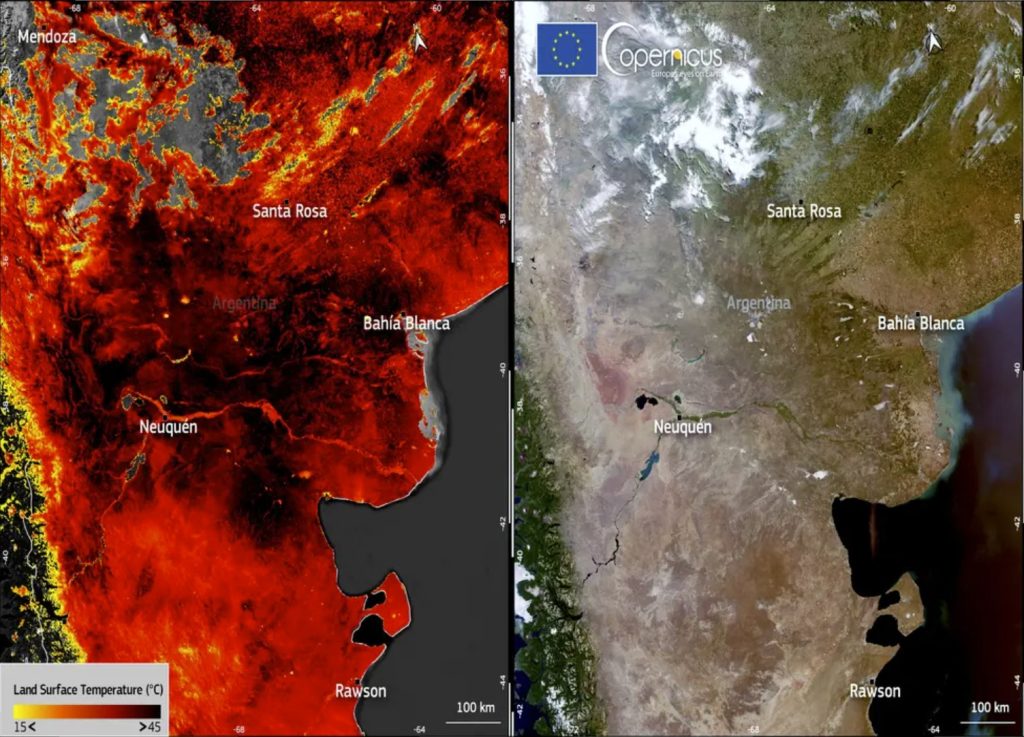
While extreme cold has gripped parts of the United States in recent days, the very opposite has been true below the equator. In the Southern Hemisphere, summer is in full swing and a heat wave could shatter century-old temperature records in South America.
The strong high pressure area over the mid-continent will result in temperatures 10-20°F (6-11°C) above normal across much of central and northern Argentina to western Uruguay, southeast Paraguay and parts of Rio Grande Do Sul through Saturday.
Heat-related power outages in Argentina
A record-breaking heatwave has hit Argentina, with temperatures soaring to 45°C (113°F) in some parts of the country. An associated spike in energy demand has caused grid failures, leading to power cuts.
Extreme heat ⚠️ building in South America is going to test infrastructure to the limit and threaten many all-time heat records.
Some areas are already under exceptional drought conditions. This incoming heatwave cannot be underestimated. pic.twitter.com/I4vXRzrUKe
— Scott Duncan (@ScottDuncanWX) January 9, 2022
At least 700,000 people were left without power in Buenos Aires on Wednesday, as residents of the Argentine capital endured sweltering temperatures amid a historic heatwave.
BREAKING: Buenos Aires, Argentina ?? falls into darkness as intense heat pushes infrastructure beyond limits.
This is one of the hottest temperatures in recorded history for the city. Unfortunately, this is only the beginning of a brutal & historic heatwave in South America. pic.twitter.com/OUi1CQ1gAY
— Scott Duncan (@ScottDuncanWX) January 11, 2022
Some local newspapers even report about 1m people without electricity:
Some reports coming in on the scale of the blackout. Unofficial reports vary widely with some unofficial claims with well over 1 million without power.https://t.co/RBvLRfvdbp
— Scott Duncan (@ScottDuncanWX) January 11, 2022
Electricity firms blamed the outage on a huge spike in demand for energy, which in turn caused technical failures and power cuts. The outage came as the temperature rose above 41°C in the capital.
The 41.1°C recorded on Tuesday at 4.05pm local time is the second-highest reading in the capital since 1906, according to city authorities. The hottest reading there is 110 F (43.3 C) from Jan. 29, 1957.
? Exceptionally hot day in #BuenosAires with 41.1°C at the Observatorio ➡️ 2nd highest temp. ever recorded at this station (all-time record: 43.3°C on Jan. 29, 1957).
44.9°C in San Juan (#Argentina ??)
43.0°C in Neuland (#Paraguay ??)
40.0°C in Florida (#Uruguay ??)#heatwave pic.twitter.com/zEUiKN9Esa— Thierry Goose (@ThierryGooseBC) January 12, 2022
Temperatures are forecast to remain high on Thursday and Friday before finally abating on Sunday. “We have to be very careful these days,” said Buenos Aires city mayor Horacio Rodriguez Larreta, as local leaders warned people to stay out of the sun and remain hydrated.
“This is a heat wave of extraordinary characteristics, with extreme temperature values that will even be analyzed after its completion, and it may generate some historical records for Argentina temperatures and persistence of heat,” meteorologist Lucas Berengua told Reuters.
The heat, which has been building since the weekend, is projected to peak from Thursday to Saturday. In this stretch, temperatures may approach the highest mark ever recorded on the continent – a staggering 120°F (48.9°C), which was recorded in Rivadavia, Argentina, on Dec. 11, 1905.
This heat wave could have also very bad effects on the Argentinan corn & soybean crops as shown in this video:
The heatwave, which has seen the country’s highest temperatures since 1957, has been driven by the Pacific Ocean’s La Nina weather pattern.
Argentina is currently the hottest place in the world, with daily highs exceeding those in Australia.A lack of rainfall has also seen water levels in the Parana River drop to an almost 80-year low.
Millions of beetles invade town
Authorities in Santa Isabel, La Pampa, were forced to turn off public lighting to chase away millions of beetles (locally known as cascarudos, diloboderus abderus or rhinoceros beetle) that invaded homes, drains, patios and swimming pools across the town.
The town of about 2,500 inhabitants is located in the middle of the desert in the west of the province of La Pampa, Argentina, where temperatures are currently very warm!
And these insects love and thrive when it’s hot outside. After burying themselves for the winter, they emerge during the summer to reproduce, attracted by the change in temperature, humidity, and streetlights.
Now officials have decided to put the city in the dark for a few days… Hopefully with positive resulst!
Again, this devastating heat is a terrifying recipe for a mass casualty event. Last summer’s Pacific Northwest heat dome killed hundreds of people w/o access to fans or air conditioning – how many Argentinians will die? How will this impact crops and the ecosphere? [Telemundo51, Accuweather, RT]
Now subscribe to this blog to get more amazing news curated just for you right in your inbox on a daily basis (here an example of our new newsletter).
You can also follow us on Facebook and/ or Twitter. And, by the way you can also make a donation through Paypal. Thank you!
You should really subscribe to QFiles. You will get very interesting information about strange events around the world.













